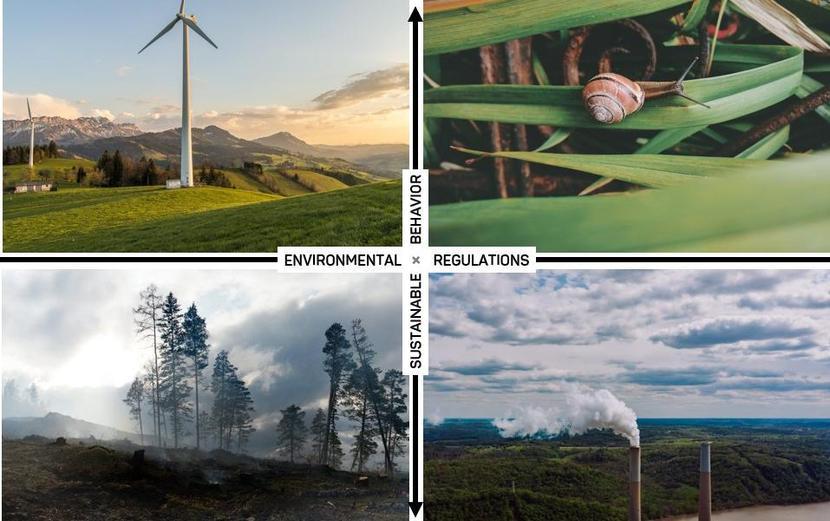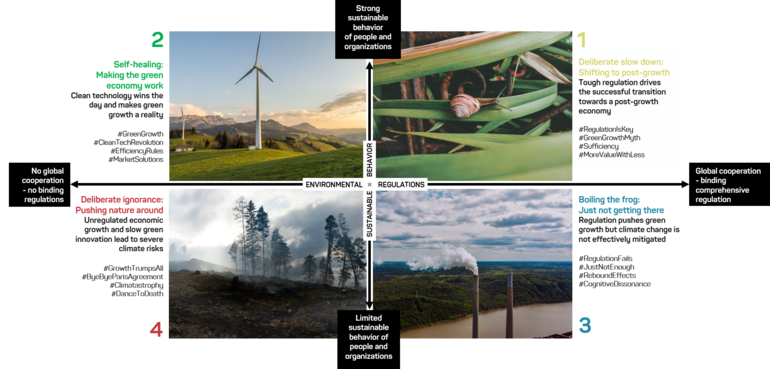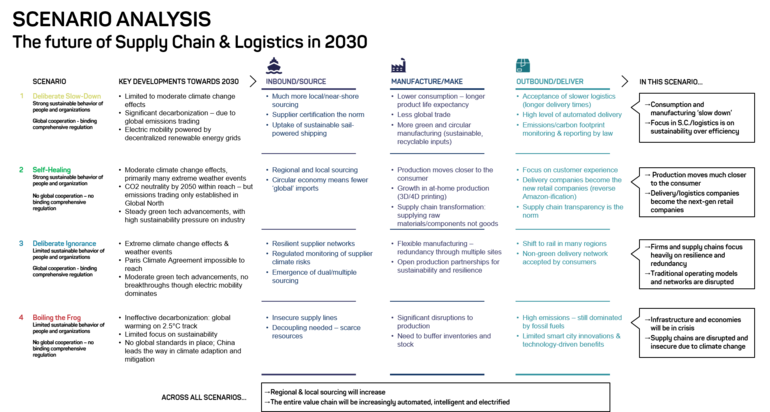
A recap on our sustainability and supply chain foresight event
As foresight specialists, we always stress the importance of preparing for multiple future outcomes. This maxim is especially true when we consider the context of climate change and its possible ramifications on supply chains–where so many variables come into play that will determine how circumstances pan out.
In a previous post, we set out some of these variables and possibilities regarding the future of our planet and explored briefly how supply chains are likely to be affected. We explained what every well-informed individual knows: That this decade is very likely to be a defining one in terms of how we address (or fail to address) climate change. We also articulated a degree of hope surrounding Joe Biden’s concerted efforts to throw the United States' weight behind the mission to offset global warming.
The extent to which climate change is offset hinges of course on how effectively governments across the world regulate against carbon emissions. As is becoming apparent, Europe will play a leading role in paving the way for carbon neutrality, a modus operandi set out in the European Green Deal. This legislation aims to achieve a climate-neutral society by investing in research and overhauling how we work, use transport, and live together while imposing strict targets.
Needless to say, businesses and supply chains with operations in Europe will need to adjust in line with these prudent changes. We argued that a proactive approach in planning ahead that explores a range of foreseeable opportunities and challenges will empower businesses to thrive in spite of the uncertainties we all face.
The art of envisioning future possibilities
But how do we plan ahead amid so many uncertainties? This is exactly what we wanted to demonstrate using the context of sustainability and supply chains in our most recent foresight event part of our series called RH Future Atelier, which brought together participants representing various industries alongside individuals from the public sector and academia.
I am pleased to say that the event was a success and am very grateful for the lively team of moderators guiding our participants on their scenarios development journey. I am also pleased to report that facilitating the workshop in MIRO was effective in bringing together so many different opinions virtually. Brainstorming can definitely be done virtually.
Four possible futures
For the uninitiated, building scenarios help us research, analyze and synthesize ideas in a way that allows us to maintain a broad perspective on how the future might unfold. We break the process down into three stages: Starting with exploring the future, moving on to analyzing key drivers, refining it all down into three to four scenarios that we can use for a number of future planning purposes, including building stories.
In this engaging two-hour session, we focused on the third stage of the process, that is: creating scenarios. We offered up four possible future scenarios and assigned participants to each one, inviting all to take a 'hands-on' approach in exploring how their respective scenario would affect supply chains, using the ‘future wheel’ as a brainstorming format.

These four scenarios were as follows: In scenario one, tough regulation brings about a deliberate slow down as we transition into a post-growth society. Scenario two sees clean technology triumph as green growth becomes a reality.
On the more dismal end of our scenarios are that of three and four. In the former, a world is envisioned where the regulations imposed do not do enough to mitigate climate change. In scenario four, we grapple with the prospect of a world in which we have truly failed the planet, and where a lack of regulation and slow green innovation mean carbon emissions remain high and companies keep sustainability to a minimum.
A multi-purpose brainstorming session
In discussing and sharing opinions on what each of these scenarios would mean for logistics and supply chains, teams were able to create vivid visions of the future. Using their Miro boards, participants worked together to weigh up what is most likely to happen in terms of social, technological, economical, ecological, and political lines, while exploring what it would mean to have to prepare for this.

The results of the discussions were intriguing and thought-provoking, and it was good to see some tangible strategies beginning to unfold that would help industry players begin to chart an adaptable course of action. For the first ‘post growth’ scenario, for example, participants considered diversifying into new businesses and partnering in the last mile distribution owing to the need for shared infrastructures in the circular economy.
Meanwhile, those considering the more disaster-struck world that was scenario 4 recognized that building resilience would be the name of the game. Ideas that came in this group included building redundancies and back-ups into logistics systems to help manage disruptions caused by extreme weather events. Participants recognized that understanding weather patterns in this world would not only help offset challenges but could also provide opportunities and influence consumer demand.
All in all, the discussions proved fruitful. I was pleased to see participants take eagerly to the creative nature of the work, just as I was intrigued to see many interesting opinions on the subject that were thrown around and debated. Regrettably, with only two hours at our disposal, we could not go through the next step–of how best to use these detailed visions. Perhaps that might be an event participants can look forward to in the future. I’d like to thank everyone for their involvement and engagement and look forward to seeing you all at our next virtual gathering.
Access the workshop documentation here.

